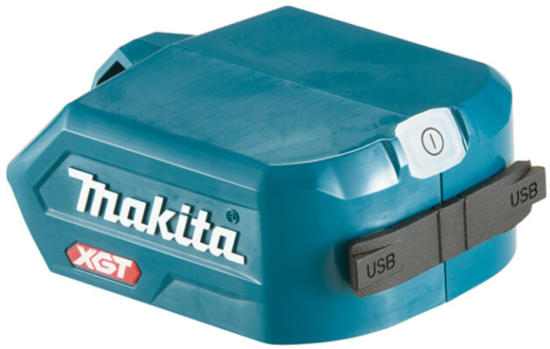Makita ADP001G Battery Adapter Instructions
makita ADP001G Battery Adapter

SPECIFICATIONS
| Model | ADP001G | |
| USB power supply | Ports | 2 (USB A type) |
| Output voltage | D.C. 5V | |
| Output current | 2.4A (each ports) (4.8A in total) | |
| Input rating | D.C. 36V – 40V max 5A max. | |
| Max. operating temperature | 40 degree C | |
| Size (L x W x H) | 96mm x 76mm x 40mm (Without battery) | |
| Weight | 0.14Kg | |
| Battery cartridge | BL4020/BL4025/ BL4040/BL4050F | |
WARNING:
Only use the battery cartridges listed above. Use of any other battery cartridges may cause injury and/or fire.
- Due to our continuing program of research and development, the specifications herein are subject to change without notice.
- Specifications may differ from country to country.
- The actual output current varies depending on the USB device to be connected.
Recommended cord connected power source
| Portable power pack | PDC01/PDC1200 |
- The cord connected power source (s) listed above may not be available depending on your region of residence.
- Before using the cord connected power source, read instruction and cautionary markings on them.
SYMBOLS

SAFETY INSTRUCTIONS
- Do not leave any cord disconnected while the battery power is supplied. Small children may put the live plug in their mouth and cause injury.
- Do not use a damaged USB cable
Important safety instructions for battery cartridge
- Recharge only with the charger specified by the manufacturer. A charger that is suitable for one type of battery pack may create a risk of fire when used with another battery pack.
- Use the product only with specifically designated battery packs. Use of any other battery packs may create a risk of injury and fire.
- When battery pack is not in use, keep it away from other metal objects, like paper clips, coins, keys, nails, screws or other small metal objects that can make a connection from one terminal to another. Shorting the battery terminals together may cause burns or a fire.
- Under abusive conditions, liquid may be ejected from the battery; avoid contact. If contact accidentally occurs, flush with water. If liquid contacts eyes, additionally seek medical help. Liquid ejected from the battery may cause irritation or burns.
- Do not use a battery pack or tool that is damaged or modified. Damaged or modified batteries may exhibit unpredictable behaviour resulting in fire, explosion or risk of injury.
- Do not expose a battery pack or tool to fire or excessive temperature. Exposure to fire or temperature above 130°C may cause explosion.
- Follow all charging instructions and do not charge the battery pack or tool outside the temperature range specified in the instructions. Charging improperly or at temperatures outside the specified range may damage the battery and increase the risk of fire.
- Before using battery cartridge, read all instructions and cautionary markings on battery charger, battery, and product using battery.
- Do not disassemble battery cartridge.
- If operating time has become excessively shorter, stop operating immediately. It may result in a risk of overheating, possible burns and even an explosion.
- If electrolyte gets into your eyes, rinse them out with clear water and seek medical attention right away. It may result in loss of your eyesight.
- Do not short the battery cartridge:
1. Do not touch the terminals with any conductive material.
2. Avoid storing battery cartridge in a container with other metal objects such as nails, coins, etc.
3. Do not expose battery cartridge to water or rain. A battery short can cause a large current flow, overheating, possible burns and even a breakdown. - Do not store the product and battery cartridge in locations where the temperature may reach or exceed 50°C (122°F).
- Do not incinerate the battery cartridge even if it is severely damaged or is completely worn out. The battery cartridge can explode in a fire.
Do not nail, cut, crush, throw, drop the battery cartridge, or hit against a hard object to the battery cartridge. Such conduct may result in a fire, excessive heat, or explosion. - Do not use a damaged battery.
- The contained lithium-ion batteries are subject to the Dangerous Goods Legislation requirements. For commercial transports e.g. by third parties, forwarding agents, special requirement on pack- aging and labeling must be observed.
For preparation of the item being shipped, consulting an expert for hazardous material is required. Please also observe possibly more detailed national regulations.
Tape or mask off open contacts and pack up the battery in such a manner that it cannot move around in the packaging. - Follow your local regulations relating to disposal of battery.
- Use the batteries only with the products specified by Makita. Installing the batteries to non-compliant products may result in a fire, excessive heat, explosion, or leak of electrolyte.
- To avoid risk, the manual of replaceable the battery should be read before use.
And the max discharging current of the battery should be greater than or equal to 8A. - If the tool is not used for a long period of time, the battery must be removed from the tool.
- During and after use, the battery cartridge may take on heat which can cause burns or low temperature burns.
- Do not touch the terminal of the tool immediately after use as it may get hot enough to cause burns.
- Do not allow chips, dust, or soil stuck into the terminals, holes, and grooves of the battery cartridge.
It may result in poor perfomance or breakdown of the tool or battery cartridge. - Unless the tool supports the use near a high-voltage electrical power lines, do not use the battery cartridge near a high-voltage electrical power lines. It may result in a malfunction or breakdown of the tool or battery cartridge.
- Keep the battery away from children.
- Danger of explosion if battery is incorrectly replaced.
- Replace only with the same or equivalent type.
Only use genuine Makita batteries. Use of non-genuine Makita batteries, or batteries that have been altered, may result in the battery bursting causing fires, personal injury and damage. It will also void the Makita warranty for the Makita tool and charger.
Tips for maintaining maximum battery life
- Never recharge a fully charged battery cartridge. Overcharging shortens the battery service life.
- Charge the battery cartridge with room temperature at 10°C – 40°C (50°F – 104°F).
- Let a hot battery cartridge cool down before charging it.
- For an optimum life-time, the battery cartridge has to be fully charged, after use.
- Charge the battery cartridge before completely discharged. Always stop tool operation and charge the battery cartridge when you notice less tool power.
- Charge the battery cartridge if you do not use it for along period (more than six months).
SAVE THESE INSTRUCTIONS.
| This device complies with part 15 of the FCC Rules. Operation is subject to the following two conditions: (1) This device may not cause harmful interference, and (2) this device must accept any interference received, including interference that may cause undesired operation. |
ICES-003 STANDARD: CAN ICES-003(B)/NMB-003(B)
INSTALLING OR REMOVING BATTERY CARTRIDGE (Fig. 1)
- Always switch off the tool before installing or removing of the battery cartridge.
- Hold the tool and the battery cartridge firmly when installing or removing battery cartridge.
To install the battery cartridge (1), align the tongue on the battery cartridge with the groove in the product and slip it into place. Insert it all the way until it locks in place with a little click. If you can see the red indicator (2) on the upper side of the button, it is not locked completely. Always install the battery cartridge fully until the red indicator cannot be seen. If not, it may accidentally
fall out of the battery holder, causing injury to you or someone around you.
Do not install the battery cartridge forcibly. If the cartridge does not slide in easily, it is not being inserted correctly. To remove the battery cartridge, slide it from the product while pressing the button (3) on the front of the cartridge.
BATTERY PROTECTION SYSTEM
When the remaining battery capacity gets low, the output power is cut off automatically for long service life of the battery. In such a situation, remove the battery cartridge from the adapter and charge it.
CONNECTING USB DEVICE (Fig. 2)
- Connect only devices which are compatible with DC 5V, 2.4A power source to the USB power supply port. Otherwise it may cause malfunction to the product.
Connect the USB cable (not included) with the power supply port (4) of the product. And then connect the other end of the cable with the device.
To start charging, press the Power button (5) to turn on the product. The Power button (5) will light up green.
When the battery capacity is low, the green light will flash for 1 minute and then the product will automatically turn off.
If the product is turned on without charging, the Power button (5) will flash green and the product will automatically turn off after 30 minutes.
When the charging is abnormal, the green light will flash quickly.
To stop charging, press and hold the Power button (5) for 3 seconds to turn off the product.
NOTE:
- Before connecting USB device to the product, always backup your data of USB device. Otherwise your data may lose by any possibility.
- The product may not supply power to some USB devices.
- Do not insert a nail, wire, etc. into USB power supply port. Otherwise a circuit short may cause smoke and fire.
- When not using, press and hold the Power button for 3 seconds to turn off the product. Otherwise the battery capacity may be reduced during course of time.
- When not using or after charging, remove the USB cable and close the cover.
- After charging or during storage, remove the battery cartridge from the adapter.
Makita Corporation
3-11-8, Sumiyoshi-cho, Anjo, Aichi 446-8502 Japan